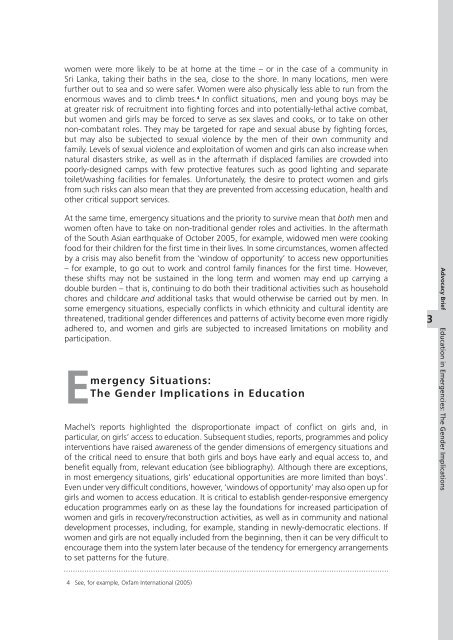Education in Emergencies: The Gender Implications - INEE
Education in Emergencies: The Gender Implications - INEE
Education in Emergencies: The Gender Implications - INEE
- No tags were found...
You also want an ePaper? Increase the reach of your titles
YUMPU automatically turns print PDFs into web optimized ePapers that Google loves.
women were more likely to be at home at the time – or <strong>in</strong> the case of a community <strong>in</strong>Sri Lanka, tak<strong>in</strong>g their baths <strong>in</strong> the sea, close to the shore. In many locations, men werefurther out to sea and so were safer. Women were also physically less able to run from theenormous waves and to climb trees. In conflict situations, men and young boys may beat greater risk of recruitment <strong>in</strong>to fight<strong>in</strong>g forces and <strong>in</strong>to potentially-lethal active combat,but women and girls may be forced to serve as sex slaves and cooks, or to take on othernon-combatant roles. <strong>The</strong>y may be targeted for rape and sexual abuse by fight<strong>in</strong>g forces,but may also be subjected to sexual violence by the men of their own community andfamily. Levels of sexual violence and exploitation of women and girls can also <strong>in</strong>crease whennatural disasters strike, as well as <strong>in</strong> the aftermath if displaced families are crowded <strong>in</strong>topoorly-designed camps with few protective features such as good light<strong>in</strong>g and separatetoilet/wash<strong>in</strong>g facilities for females. Unfortunately, the desire to protect women and girlsfrom such risks can also mean that they are prevented from access<strong>in</strong>g education, health andother critical support services.At the same time, emergency situations and the priority to survive mean that both men andwomen often have to take on non-traditional gender roles and activities. In the aftermathof the South Asian earthquake of October 2005, for example, widowed men were cook<strong>in</strong>gfood for their children for the first time <strong>in</strong> their lives. In some circumstances, women affectedby a crisis may also benefit from the ‘w<strong>in</strong>dow of opportunity’ to access new opportunities– for example, to go out to work and control family f<strong>in</strong>ances for the first time. However,these shifts may not be susta<strong>in</strong>ed <strong>in</strong> the long term and women may end up carry<strong>in</strong>g adouble burden – that is, cont<strong>in</strong>u<strong>in</strong>g to do both their traditional activities such as householdchores and childcare and additional tasks that would otherwise be carried out by men. Insome emergency situations, especially conflicts <strong>in</strong> which ethnicity and cultural identity arethreatened, traditional gender differences and patterns of activity become even more rigidlyadhered to, and women and girls are subjected to <strong>in</strong>creased limitations on mobility andparticipation.Emergency Situations:<strong>The</strong> <strong>Gender</strong> <strong>Implications</strong> <strong>in</strong> <strong>Education</strong>Machel’s reports highlighted the disproportionate impact of conflict on girls and, <strong>in</strong>particular, on girls’ access to education. Subsequent studies, reports, programmes and policy<strong>in</strong>terventions have raised awareness of the gender dimensions of emergency situations andof the critical need to ensure that both girls and boys have early and equal access to, andbenefit equally from, relevant education (see bibliography). Although there are exceptions,<strong>in</strong> most emergency situations, girls’ educational opportunities are more limited than boys’.Even under very difficult conditions, however, ‘w<strong>in</strong>dows of opportunity’ may also open up forgirls and women to access education. It is critical to establish gender-responsive emergencyeducation programmes early on as these lay the foundations for <strong>in</strong>creased participation ofwomen and girls <strong>in</strong> recovery/reconstruction activities, as well as <strong>in</strong> community and nationaldevelopment processes, <strong>in</strong>clud<strong>in</strong>g, for example, stand<strong>in</strong>g <strong>in</strong> newly-democratic elections. Ifwomen and girls are not equally <strong>in</strong>cluded from the beg<strong>in</strong>n<strong>in</strong>g, then it can be very difficult toencourage them <strong>in</strong>to the system later because of the tendency for emergency arrangementsto set patterns for the future.Advocacy Brief <strong>Education</strong> <strong>in</strong> <strong>Emergencies</strong>: <strong>The</strong> <strong>Gender</strong> <strong>Implications</strong> See, for example, Oxfam International (2005)
















